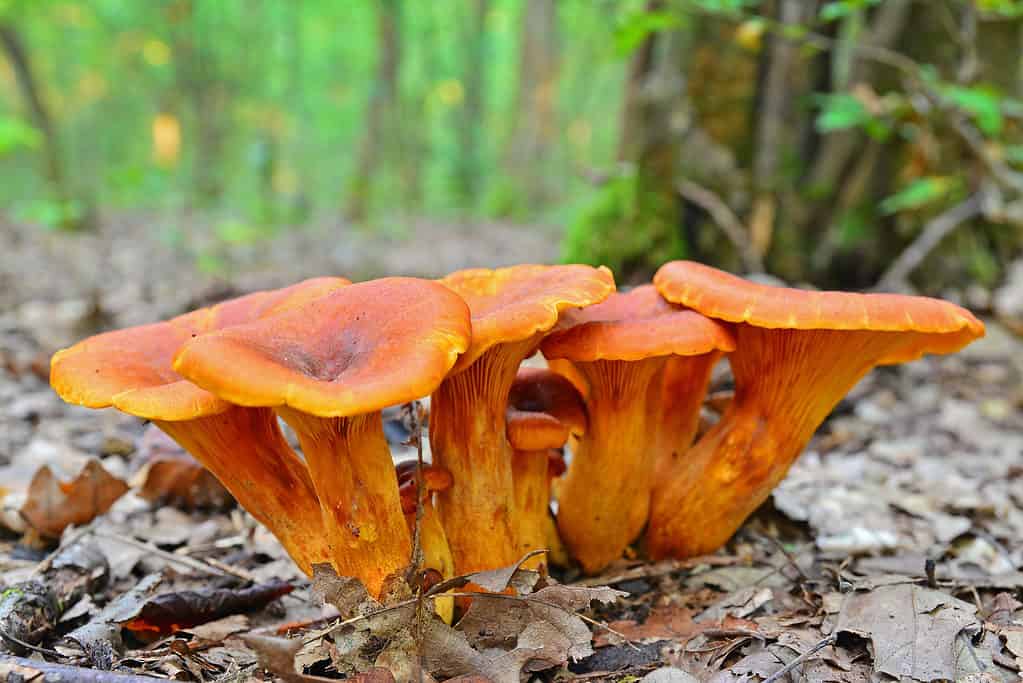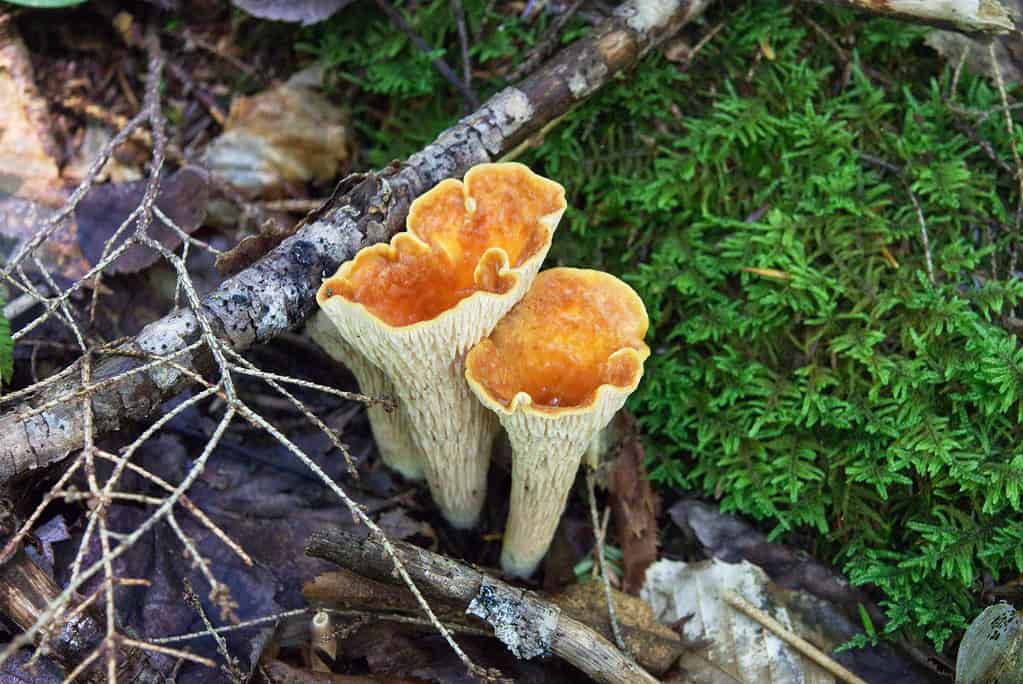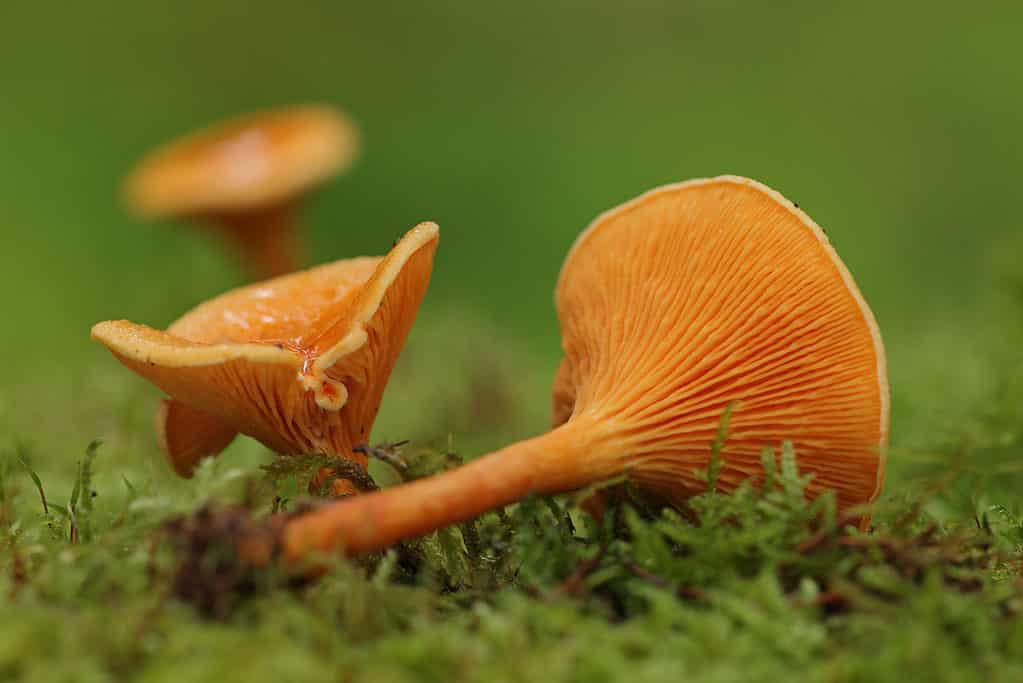If you enjoy foraging for chanterelle mushrooms, it’s crucial to know how to Identify look-alikes in your area. By knowing how to distinguish between true chanterelles and their lookalikes, you can better ensure that you’re foraging the choice, edible species you’re looking for.
In this guide, we’ll cover the three main species of North American mushrooms that you are most likely to mistake for true chanterelles and explain the key differences between them.
Read on to learn more!
What Are Chanterelle Mushrooms
Chanterelles are edible mushrooms belonging to the Cantharellus genus of the Cantharellaceae family. All identified species of chanterelles are edible, although some species are more sought after for their complex, rich taste than others. One of the most well-known is the golden chanterelle, Cantharellus cibarius, which only occurs in Europe. In North America, over a dozen species exist that look and taste very similar to C. cibarius, such as the Pacific golden chanterelle, Cantharellus formosus.
Chanterelles range in color from orange, yellow, white, and red. The vast majority of chanterelles, however, are yellow to orange in color in various shades from the cap to the base of the stem (aka the stipe). Most chanterelles feature false gills or ridges (more on that below), but some are completely smooth underneath. You’ll also note that the majority of chanterelle species feature a stipe that appears to morph into the cap rather than featuring well-defined boundaries of cap and stipe, especially at maturity.
Additionally, all chanterelles form mycorrhizal relationships with their plant hosts. This beneficial plant-fungi partnership results in the roots of plants receiving essential nutrients from the mycelium of chanterelles, while the mycelium receives vital sugars from the roots of the host tree. Depending on the species, chanterelles can form mycorrhizal associations with conifer and hardwood trees.
3 True Chanterelle Lookalikes
Below, we’ll cover the morphological characteristics, ecology and distribution, and toxicity status of three species of North American mushrooms that look like true chanterelles.
1. Jack-o’-Lantern Mushroom (Omphalotus spp.)

©bogdan ionescu/Shutterstock.com
If at night you’ve ever come across clusters of orange mushrooms with lightly glowing caps and gills, you may very well have found the quite lovely and also rather poisonous jack-o’-lantern mushrooms. These mushrooms share some resemblance to orange chanterelle species, so it’s important to be able to distinguish between them.
Distribution and Ecology
Omphalotus illudens is one of the more well known jack-o’-lantern species endemic to North America. It is rumored that this species can be found in Europe as well, although rare. In forested areas across central and southern Europe, the most common species you’ll find is Omphalotus olearius, which appears extremely similar to and shares the common name of O. illudens. Another species of jack-o’-lantern mushrooms, O. olivascens, occurs throughout the western range of the US. There is even yet even another species in the U.S., but it has just recently been identified and has a limited range near the Gulf Coast, Omphalotus subilludens.
These mushrooms are saprobic, meaning they derive their nutrients from breaking down dead organic matter. For jack-o’lantern mushrooms, this organic matter is typically hardwood logs and stumps, especially oak species.
You can find these mushrooms fruiting from late summer through fall, overlapping with the chanterelle season.
Bioluminescence
The glowing that occurs in jack-o’-lantern mushrooms is called bioluminescence. It is currently confirmed to occur in over 80 species of mushrooms amongst many genera. When in the presence of oxygen, a reaction between a chemical in these mushrooms, called luciferin, and the enzyme luciferase, produces oxyluciferin. It is oxyluciferin that is responsible for emitting the beautiful glowing light of bioluminescent mushrooms. Some researchers hypothesize that this glowing helps attract insects to the spore-bearing tissues of these mushrooms. If you would like to view this phenomenon yourself it’s best to find extremely young specimens and take them home to a dark place like a closet. It may take some time for your eyes to adjust and to see it.
Toxicity
The chemical that makes jack-o’-lantern mushrooms toxic is called Illudin S. Ingestion of jack-o’-lantern mushrooms, raw or thoroughly cooked, typically results in quite intense gastrointestinal upset. Symptoms include vomiting, cramps, stomach pain, weakness, and diarrhea.
Distinguishing Jack-o’lantern Mushrooms vs. Chanterelles
To the untrained eye, jack-o’-lantern mushrooms can be mistaken for various species of chanterelles, especially more orange-colored ones like Cantharellus enelensis. However, there are some key distinctions that can help you distinguish chanterelles from jack-o’-lanterns.
Gills vs. False Gills
One of the most notable distinctions is that chanterelles don’t have true gills, while jack-o’-lantern mushrooms do. Chanterelles have a primitive form of gills that are difficult to separate from the rest of the mushroom, are sometimes forked, don’t move when you run your thumb across them, and look more like ridges than paper-thin slits. Note that the smooth chanterelle (Cantharellus lateritius) barely even has these primitive gills, and instead appears almost smooth under the cap and along the upper portion of the stipe.
In contrast, Omphalotus illudens and allied species have true gills that move when you run your thumb across them, can be separated from the rest of the mushroom, and look more like delicate, thin slits rather than rubbery ridges.
How They Grow
Chanterelles are mycorrhizal, while jack-o’lantern mushrooms are saprobic. As mycorrhizal mushrooms, chanterelles derive their nutrients from a mutually beneficial plant-fungi nutrient exchange. As such, you won’t find chanterelles growing from wood like jack-o’-lanterns. Instead, chanterelles will be growing from the soil near their tree associates. If you find jack-o’-lanterns that seem to be growing from the soil, try unearthing around the mushroom. You should find decomposing bits of wood or roots that the mushrooms are actually fruiting from.
Additionally, while you can find chanterelles scattered across the forest floor, they don’t typically cluster nearly as tightly as jack-o’-lantern mushrooms do. Although some species of chanterelles, like Cantharellus odorotus, do commonly grow in clusters.
Compare the Stipe
When comparing these two mushrooms, you’ll notice that the stipes are quite different. Many species of chanterelles, especially when mature, have stipes that broaden toward the cap, and can appear to morph into the cap. The chanterelle stipe will also pull apart like string cheese.
Jack-o’-lantern mushrooms, in comparison, don’t have this tapering of the stipe. Instead, the stipe of jack-o’-lanterns tends to be uniform from the base to the tip.
In comparison to chanterelles, the stipe and cap also appear much more like distinct structures with more defined boundaries.
2. False Scaly Chanterelle (Turbinellus floccosus)

©Cliff Seruntine/Shutterstock.com
The false scaly chanterelles (Turbinellus floccosus and Turbinellus kauffmanii) have some morphological features similar to that of true chanterelles. So, if you’re foraging for chanterelles in these mushroom’s growing region, it’s a good idea to become familiar with them.
Distribution and Ecology
Occurring throughout temperate forests of North America, the false scaly chanterelles are mycorrhizal in mixed conifer forests. It can appear alone or in scattered clusters. They appears from late summer through fall, overlapping with the chanterelle season.
Toxicity
At one point these mushrooms were part of the Cantharellus genus, so people have eaten them, but they aren’t considered a common edible in North America these days. The North American species can cause nausea, vomiting, and diarrhea upon ingestion, even when thoroughly cooked, for some people. Most North American guides consider the edibility of these species as questionable though likely of low toxicity. However, more research likely needs to be done on this species for a more definitive answer. Your safest bet currently is to avoid ingesting these mushrooms.
Distinguishing the False Scaly Chanterelle from True Chanterelles
To distinguish between Turbinellus floccosus and true chanterelles, you’ll need to become familiar with the morphological distinction between these mushrooms. The species of chanterelle that probably looks the most like Turbinellus floccosus is Cantharellus californicus. This is due to the robust girth of this species of true chanterelle.
The Stipes
Firstly, you’ll notice that T. floccosus has a similar funnel shape to that of chanterelles. Its stipe broadens toward the cap, and the stipe and cap can appear like one, inseparable structure, as with many species of true chanterelles.
The Caps
However, the cap of the false scaly chanterelle creates much more of a deep vase shape than true chanterelles. The color of the cap can range from orange to brown-orange or brown-red. Unlike true chanterelles, this species often develops rings of scales around the cap.
The Gills
Like true chanterelles, the false scaly chanterelle species also has false gills that present as shallow, wrinkled ridges that are typically pale yellow to off-white in appearance. However, the false gills on Turbinellus floccosus tend to look more like dense folds and wrinkles than the more defined ridges of chanterelles.
3. False Chanterelle (Hygrophoropsis aurantiaca)

©Bildagentur Zoonar GmbH/Shutterstock.com
Our final species of chanterelle lookalikes is the false chanterelle, Hygrophoropsis aurantiaca. The false chanterelle doesn’t quite resemble Cantharellus cibarius-like species. However, without knowing how to distinguish them, you could mistake this mushroom for the cinnabar chanterelle (Cantharellus cinnabarinus) or the Appalachian chanterelle (Cantharellus appalachiensis). Strangely, this mushroom is more closely related to the boletes than it is to chanterelles.
Distribution and Ecology
The false chanterelle of the Hygrophoropsidaceae family grows widely across temperate forested regions of North America. Unlike true chanterelles, however, it does not form mycorrhizal associations with trees. Instead, the false chanterelle is saprobic, deriving its nutrients from dead organic matter. Specifically, the false chanterelle grows from leaf litter and rotting wood across the forest floor.
Hygrophoropsis aurantiaca typically appears from July through November, overlapping with the true chanterelle season.
Toxicity
The edibility of the false chanterelle is debatable with many North American field guides listing the edibility status as questionable or inedible. There have been several reports of people developing gastrointestinal upset after ingesting them. However, people of some cultures do routinely eat this mushroom without trouble. Again, like the false scaly chanterelle, more research may be needed to have a more definitive answer on the edibility of this mushroom. Your best bet is to stick with cooking up and chowing down on true chanterelles.
Distinguishing Between the False Chanterelle and True Chanterelles
Especially if you’re foraging in areas with the cinnabar or Appalachian chanterelle, it’s important to be able to discern the morphological differences between the false chanterelle and true chanterelles. Below we’ll cover some distinguishing features.
The Stipes
Unlike true chanterelles, mature false chanterelles don’t have stipes that broaden toward the cap. Instead, they tend to stay uniform in shape from the base to the top of the stipe. Additionally, the color of the stipe is often darker than the cap. This contrasts with true chanterelles, which typically feature stipes that are the same color or a bit paler than the cap. The false chanterelle is also a much more flimsy mushroom as a whole compared to the more robust chanterelles.
The Caps
The cap of the false chanterelle is typically convex with margins rolled inward when young. As it matures, the false chanterelle can become broadly convex, flat, or develop a shallowly umbelliform shape. When comparing the cap color of the false chanterelle to the yellow-peach colored caps of C. cibarius-like species, you’ll notice that it is darker orange to brown. However, it can closely resemble the cap of C. appalachiensis.
The Gills
Perhaps the most notable difference between Hygrophoropsis aurantiaca and true chanterelles is that the former has true gills. You’ll notice on the false chanterelle, that the gills are forked, delicate, paper-thin, moveable, and you can easily separate them from the rest of the mushroom. True chanterelles, as we mentioned above in comparison to jack-o’-lantern mushrooms, have false gills (aka ridges or primitive gills). These false gills are rubbery, broader, ridge-like, don’t move when brushed, and aren’t easily separated from the rest of the mushroom. Additionally, the false gills of true chanterelles run further down the stipe than the true gills of H. aurantiaca.
The post 3 Mushrooms that Look Like Chanterelles appeared first on AZ Animals.
from Animal News, Facts, Rankings, and More! - AZ Animals https://ift.tt/KFWi4sw